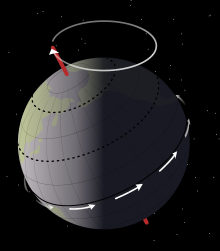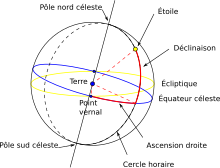Differences between “zodiacal constellations” and “signs” of tropical astrology
Polaris , Thuban and Vegaas polar stars over millennia
Because of the precession of the equinoxes, the axis of the terrestrial poles carries out in 25 770 years 3 a rotation similar to that, much faster (a few seconds), of a gyroscope 4 . Observe, however, that it is the attraction of the Moon orbiting the Earth that causes this gradual shift. If we project the axis of the poles towards the celestial vault, we observe a circular path. Currently, the North Pole points to the star we call “polar”, Polaris , but that has not always been. In 2000 BCE, the polar star was Thuban , a star of the constellation Draco (the Dragon). In 11,000 BCE, it was, to a few degrees, Vega de laLyre .
Even if the axis of the poles rotates thus, the inclination of this axis, on the other hand, does not vary: it is 23 degrees and a half, approximately, an angle of inclination comparable to that of this gyroscope 5 .
It is at this inclination that the seasons are due : from Earth, always “leaning” towards Polaris (since a few centuries), we see (if for example we are in the Northern Hemisphere), the Sun longer and higher in the sky – it is summer (that is to say that the duration day decreases with respect to that of the night) 6 – if it is placed closest to this star 7 ; if, in other words, we are “bent” towards a Sun appearing to be in the tropical sign of Cancer(corresponding more or less to the constellation Gemini ) neighbor Polaris. In contrast, in winter(the day’s duration increases compared to the night), we are still bent in the same direction, but, the Earth having done half a cycle, the Sun seems to be closer to the tropical sign of Capricorn(corresponding little or less in the constellation Sagittarius ), and it appears only slightly and rises slightly in heaven 7 . We are leaning on the other side 8 . In truth, the inclination has not changed, it is our position relative to the Sun which has changed in six months.
Vernal point , axis of the equinoxes and axis of the solstices
Alternating seasons in the Northern Hemisphere .
When the Earth is leaning as far as the sun, it is the boreal summer (the Sun is higher than the plane of the celestial equator ); in contrast, six months later, the northern winter begins (the Sun is lower than the plane of the celestial equator). These two positions of the Earth with respect to the Sun form the axis of the solstices . When the Earth is halfway between these two dates, it is the equinoxes (the duration of the day is equal to that of the night) of spring and autumn(The Sun meets the plane of the celestial equator). These two moments of the Earth-Sun system form the axis of the equinoxes. Since this cycle is entirely dependent on the inclination of the Earth, the movement of the pole axis will cause the stellar background in front of which the Sun is at each moment of the cycle to change.
Twelve constellations, of very different sizes and conformations, seem to mark out the apparent path of the Sun in twelve months: these are the zodiacal constellations. There is, however, no necessary connection between, for example, the constellation of Aries and the month of the Aries sign of the tropical zodiac (the first month of spring, marked by the passage of the Sun to the vernal point ); there are 13 000 years, Aries sidereal was not the tropical background of the Sun to the season of spring , but to fall . Indeed, the signs of the tropical zodiac (linked to the seasons) have retained the name of the constellations which corresponded to it when this zodiac was preferred to the zodiac of the constellations9 , while the constellations are gradually shifted with respect to the seasons, due to the precession of the equinoxes .
There is only one tropical zodiac because there is only one vernal point .
Hindu Astrology
There are several stars in the Hindu who serve as a point of reference for their sidereal zodiac . There are two main systems, which differ very little:
- the fixed star Revati (en) ( right ascension 01 h 13 m 43.80 s and declination + 07 ° 34 ‘31.8 “) corresponds to the degree of 29 ° 50 sidereal sign of fish ; it is ayanamsa advocated by Bangalore Venkata Raman 10 .
- the star Spica (right ascension 13 h 25 m 11,587 s and declination -11 ° 09 ‘40,71 “) corresponds to the zero degree of the sidereal sign of the Balance 11 . This is the ayanamsa Lahiri , who is the one officially adopted by the Government of India 12 .
It follows from the above that there are several ” Ayanamsas ” different (and several different sidereal zodiac) which fortunately differ little 13 .
The star of Aries that serves as the starting point of this division equals 12 is quite insignificant visually (less than 1% brightness of that of Vega , which corresponds to the apparent magnitude of reference). It was chosen only because it was part of an ecliptic – clad device inspired by the 12 months of the terrestrial year with regard to the iconography of seasonal activities as described in the almanacs , the books of hours and on the cathedrals.
https://fr.wikipedia.org/wiki/Ayanamsa







 நவீன தொலைநோக்கி துணையுடன் கண்களால் பார்த்து மற்றும் தொலையுணர் விஞ்ஞான கருவிகள் கொண்டு சந்திர கிரகநிலையை மிக துல்லியமாக கணித்தும், அதன் அடிப்படையில் உயரிய சிக்கலான கணித சூத்திரங்கள்(
நவீன தொலைநோக்கி துணையுடன் கண்களால் பார்த்து மற்றும் தொலையுணர் விஞ்ஞான கருவிகள் கொண்டு சந்திர கிரகநிலையை மிக துல்லியமாக கணித்தும், அதன் அடிப்படையில் உயரிய சிக்கலான கணித சூத்திரங்கள்(
Leave a Reply
You must be logged in to post a comment.